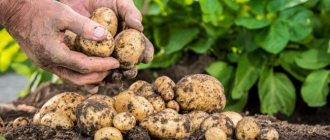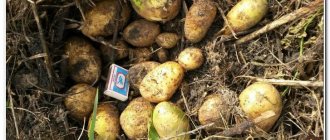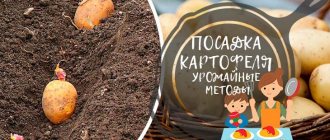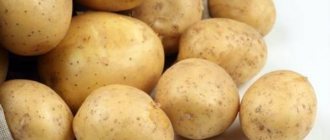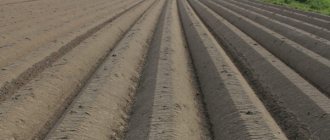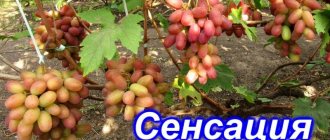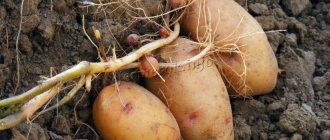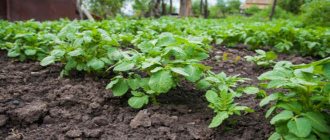Characteristics of potatoes "Rodrigo"
Photos of Rodrigo potatoes and descriptions of the variety do not leave indifferent people who know a lot about growing root crops. Planting the variety can be called a bold experiment, since the soil and climate of the regions of Russia differ significantly from the soil of Germany. A short experience of growing Rodrigo potatoes showed the following results:
- In order for the root crop to ripen, it takes 2 – 2.5 months;
- in terms of taste, it can rightfully belong to the table varieties;
- bushes are medium in size, but mostly reach a meter;
- spreading shoots are a good protection of the soil from drought;
- the leaves are not large in size, but they cannot be classified as small either;
- at the time of flowering, the bushes are covered with red-violet flowers;
- root vegetables of the Rodrigo variety are large, oval-shaped and bright pink;
- conditional maturity occurs before technical maturity.
Important!
According to experts, peeling root vegetables are not considered ripe and are not recommended for use as food. The Rodrigo potato has aroused interest among domestic agronomists, as its characteristics are very tempting:
- High yields - one hundred square meters produces up to 600 kg of tubers. Rodrigo potatoes are large in size and there are no small root crops under the bush. The weight of the tubers varies between 200 and 800 g.
- The culture contains up to 15% starch, this is a high figure.
- Rodrigo potatoes tolerate transportation and transportation over long distances well.
- During storage under optimal conditions, no more than 5% of fruits are susceptible to defects.
- The variety's resistance to viruses and disease is average.
Important! Stemless, semi-erect potato bushes of the Rodrigo variety are represented by several branches. The fact that the root crop is ripe is indicated by the lost shape, yellowed, disintegrated aerial part.
In 2008, the variety was registered in the State Register of the Russian Federation (official name “Rodriga”) as recommended for cultivation for the Central, Volga-Vyatka, North Caucasus, Middle Volga, and Far Eastern regions.
The description of the Rodrigo potato satisfies the needs of agronomists and arouses genuine interest; it is successfully grown in all regions of the country.
Distinctive features of the variety
Despite the fact that Russian gardeners have been growing Rodrigo potatoes on their plots only recently, this variety has already earned a lot of positive reviews and is becoming increasingly popular.
The variety showed excellent results in the southern regions, as well as in areas with more severe climatic conditions. However, the catalogs indicate that experts recommend growing the Rodrigo potato variety in the middle Volga region.
Rodrigo is a mid-early variety in terms of ripening time. The growing season ranges from 70 to 85 days. This is exactly how long it takes for the skin of a potato of this variety to become sufficiently dense and tough. However, just 2-2.5 months after planting, you can already try the first young potatoes by digging up several bushes.
According to the description of the variety and reviews (which is clearly visible in the photo), the bushes of the Rodrigo potato consist of an average of 3-5 shoots. The stems are tall, reaching 75-80 cm. As the potatoes ripen, the bush gradually disintegrates and the stems droop.
Interesting! In many catalogs, the Rodrigo potato variety is listed under the name “Rodriga”.
Rodrigo does not have many leaves, but they are large, with barely noticeable wavy folds along the edges. During flowering, the number of inflorescences is insignificant. The petals are pale lilac, sometimes reddish with a pink tint.
According to the description of the variety, the tubers of Rodrigo potatoes in the full maturity phase reach a weight of 90-150 grams. However, in reality, many gardeners note that if you follow the rules of agricultural cultivation, you can reap a richer harvest. Some tubers reach a weight of 300-350 grams, and even up to 0.5 kg.
From one bush you can collect 7-10 potatoes. There are no small and gnarled tubers observed. For the most part, all potatoes of this variety are medium or large in size, smooth, without flaws, elongated, oval in shape.
The skin of Rodrigo potatoes is pale raspberry or dark pink in color, smooth to the touch, and quite dense to withstand a long shelf life. A small number of ocelli are located on the surface, without excessive depression. Any housewife will appreciate this feature of the variety, since peeling potatoes will not take much time.
The flesh of Rodrigo potatoes is yellowish-cream in color. The starch content is low, at the level of 12.5-15.5%, which determines a wide range of its application. It doesn’t get soft or crumble when cooked, it keeps its shape perfectly.
Interesting! Since ancient times in Rus', the appropriate planting time was determined by signs: potatoes were planted after the first thunderstorm, during the flowering of bird cherry, dandelions and lilacs.
Taste qualities
Many people liked the taste of the Rodrigo variety. Due to the high starch content, dishes turn out rich and potatoes become crumbly.
According to the method of application, the variety is considered universal. Various dishes are prepared from it, starch and alcohol components are produced. Rodrigo potatoes are rich in minerals (potassium, phosphorus, calcium), vitamins (ascorbic acid, B, A, carotene). It also contains solanine, but if stored properly, the amount of the toxic substance does not exceed normal limits. It is unacceptable to keep the tubers in the open sun. To avoid the appearance of green spots - places where solanine accumulates, the crop should be stored in a dark place.
Important! Old, wrinkled, sprouted potatoes with signs of greenery should not be eaten. Such tubers lack beneficial substances and are dominated by toxins.
Since the pulp of Rodrigo potato tubers is intensely yellow or creamy, the result is aesthetically attractive dishes (mashed potatoes, soups). Among other things, a rich shade indicates the presence of a high concentration of carotene. The valuable properties of the substance to remove toxic compounds from the body have been known for a long time.
Boiled potatoes of the Rodrigo variety are aromatic, with a delicate texture. It has a rich, sweetish taste.
Advice from experienced gardeners and reviews about the Rodriga variety
Gardeners mostly leave positive reviews about the Rodrigue potato variety.
Larisa, Balashikha: “For the first time I grew the Rodrigue potato variety, or, as we called it, Rodriguez. When planting, the tubers had to be cut into 3 parts. They were grown like other varieties, only they were dug up earlier. All the tubers turned out about the same, the taste is excellent!”
Alexander, Tver: “Our family really loves the Rodrigo potato variety. Of course, you have to fight the Colorado potato beetle, but the rich harvest is worth it! Our secret is that we germinate tubers in plastic bags.”
Valentin, Belgorod: “This undemanding variety survived the hot summer perfectly, the harvest appeared in 70 days, and this is on not very rich soil! It stores well, even if the tubers are damaged by a shovel.”
Pros and cons of the Rodrigo potato variety
In order to identify the shortcomings of the Rodrigo variety, a testing commission was involved. The conclusion is clear: the quality characteristics are stable.
Among the noted advantages of the Rodrigo variety:
- good harvest;
- ideal shape, large root vegetables;
- high percentage of marketability;
- unpretentiousness to weather conditions (heat, drought);
- no requirements for soil composition;
- not susceptible to most diseases;
- does not lose quality during transportation;
- preserves well for a long time;
- has excellent taste;
- versatility of application.
The Rodrigo variety deserves attention, as it has many advantages over others and has no disadvantages. Having mastered the tactics of growing potatoes, you can get a high yield.
The main enemies of the crop
The Rodrigo variety is genetically resistant to the pathogen of potato cancer and to the golden potato nematode. Among diseases, its main problem is late blight; among pests, it is the Colorado potato beetle, mole cricket and wireworms.
Table of protective and preventive measures against potato diseases and pests
| Name | Signs | Prevention methods | Ways to fight |
| Late blight | Dark brown spots on leaves and tubers |
| Spraying with copper-containing preparations at the first signs of disease on the leaves |
| Colorado beetle | Leaves eaten; bright orange-red larvae and yellow-black striped beetles are visible |
| When the first larvae appear, spray with Kinmiks, especially carefully on the underside of the leaves. |
| Medvedka | Large insects up to 8 cm long, living in burrows and feeding on tubers and roots | When planting potatoes, adding granular preparation Barguzin to the soil | |
| Wireworms (larvae of click beetles) | Tough yellowish-brown “worms” that gnaw holes in potato tubers |
Photo gallery of the main enemies of potatoes
Late blight appears on the leaves as dark spots.
Tubers affected by late blight turn brown and rot
Adult click beetles are harmless, but their larvae, wireworms, are dangerous.
Wireworms are the main cause of worminess in potatoes
Mole crickets damage potato roots and tubers
When planted “under straw”, potatoes may suffer from slugs
Colorado potato beetles appear in spring
Oviposition of the Colorado potato beetle is located on the underside of potato leaves.
Colorado potato beetle larvae are very voracious
Planting and caring for Rodrigo potatoes
To get a good harvest of Rodrigo potatoes, gardeners must know some nuances.
Selection and preparation of a landing site
Although this potato variety is considered unpretentious, it has been noted that it grows well on loamy and sandy loam soils with acidity varying from 5.5 to 7.
Before planting the Rodrigo variety, the area is cleared of weeds, branches and last year's debris. When digging in spring, the soil is saturated with humus and wood ash.
For 1 m2 you will need:
- humus - 0.5 buckets;
- ash – 200 g;
- supersulfate – 30 g;
- ammonium nitrate – 15 g;
- potassium chloride – 10 g.
All necessary inclusions are distributed evenly around the entire perimeter, and the area is dug up. Important! Manure should not be fresh, as this may negatively affect the quality of the crop. You should also know that you cannot plant Rodrigo potatoes more than twice in one place. Good results can be obtained on soils after growing cabbage, pumpkin and legumes.
Preparation of planting material
Small tubers are selected for seeds. The ideal size of planting material is considered to be a root crop the size of a chicken egg.
To get an early harvest of Rodrigo potatoes, the tubers are exposed to warm temperatures (+15oC) for germination. The room should be bright. During the germination of sprouts, it is necessary to inspect and remove affected tubers. If seed potatoes are wrinkled, they can be irrigated periodically with water.
It is worth noting that choosing the required sizes of planting material in this variety is quite difficult. Since planting 200, 500, 800 g of tubers is not economical, each potato can be cut into 2 - 3 parts.
Important! There should be at least two sprouts on each piece.
Landing rules
To obtain the highest quality harvest of Rodrigo potatoes in large volumes, you should follow the scheme of experienced home gardeners:
- marking is carried out on the dug up area using two stakes and a cord;
- maintain a distance between rows of 70 cm;
- grooves are dug under the cord with a depth of up to 15 cm;
- Seeds are laid along the recess (at a distance of 30 cm);
- pay attention to the cut - it should be at the bottom;
- fall asleep with caution - there should be at least 7 cm of soil above the tuber.
It is worth noting that if the soil is light and sandy, the layer for covering the seeds can reach 12 cm.
If planting is carried out in excessively damp soil, you should immediately notice that the potatoes are not cut in this case. It is advisable to prepare ridges at the site of future grooves for planting in the fall. Since such mounds warm up faster in the spring, seeds are planted in them.
Important! Before starting planting work, you should measure the soil temperature at a depth of 10 cm. The heated soil should be at least +7oC. To prevent seedlings from appearing during the frost period, when planting, they are guided by the moment the birch leaves bloom and the dandelions begin to bloom (beginning of May). In a climate with frequent spring frosts, you should not rush to plant Rodrigo potato seeds in the ground: planting should be postponed until the bird cherry flowers fall or the lilacs begin to bloom.
If the above-ground part is frozen, it turns black and disappears. Potatoes in the ground will continue to develop, but at a slower pace. The output yield will be significantly lower than expected.
Watering and fertilizing
Tubers are formed before flowering begins. At this stage it is important that the soil is moist. Before the heat sets in, the potatoes are fully formed. At +25oC the growth process slows down. During a period of drought, in the absence of watering, there is a high probability of obtaining a small harvest.
If there is no rain and is not expected, then it is recommended to irrigate once a week, until the soil is wet by 20 cm. The best way to moisturize is drip irrigation. When resorting to sprinkling, you need to know that there is no late blight on the site. This method is only permissible at the beginning of the growing season.
During the growth process, Rodrigo potatoes need to be fed. For this purpose, organic fertilizers (ash, urea) and mineral fertilizers (superphosphate, potassium chloride) are used. How to properly saturate the soil is indicated on the packaging.
Fertilizing is done three times:
- With the growth of stems and greenery.
- During the formation of buds.
- During the flowering phase.
This provides ideal conditions for tuber formation.
Additional information on watering and fertilizing is in the video:
Loosening and weeding
Weeds are a source of dangerous plant diseases. It is important to ensure that there are no weeds between the potato bushes. Deep loosening promotes normal crop growth.
Typically, loosening the soil is indicated after rain, but in dense soils you should not wait for precipitation.
Hilling
Along with the first weeding, when the stems grow up to 20 cm high, it is recommended to hill up the bushes. The event allows you to achieve optimal soil moisture at the base of the stems, which subsequently has a positive effect on the formation of tubers. To form mounds, the soil is raked up to the stems with a hiller.
Important! There is no point in hilling dry soil.
Potatoes of the Rodrigo variety are sprinkled with soil at the base only once. It is necessary to take into account the climatic features of the region. If the places are dry, then when planting the tubers can be deepened to 12 cm. In a rainy location, repeated hilling may be necessary.
Reviews from gardeners
Rodrigo is a very good potato, very large and productive. And Lasunok did not show itself for the second year - it was completely unproductive. I won't repeat it again.
ElenaN
https://www.tomat-pomidor.com/newforum/index.php?topic=201.38…
Today I took the risk of digging up Rodrigo, my hands are really itching. The largest tuber is 150 g, from two bushes there are eight large tubers and the same number of smaller ones. But he still has to grow and grow. They promised that this was a large-fruited variety. I doubted it, because the bush has two, maximum three shoots, the thickness of a woman’s little finger, while Adretta’s, for example, is 2–4 times thicker. And most importantly, the tops died down even before flowering, on June 15th. The main thing is that the bush is green, vigorous, and the tops are as before harvesting. I cooked it - the potatoes were crumbly and tasty, no worse than Adretta.
Newbie amateur
https://farmerforum.ru/viewtopic.php?t=649&start=50
Potatoes were planted as usual. Imagine our amazement when we started digging for the Rodrigo variety! Each nest contains 7–9 smooth, huge tubers, 700–800 g each. There was also a record holder - 1200 g. But the most amazing thing is the taste. I have never eaten such delicious puree before. You can safely write that this variety is one of the ten best varieties.
Arken
https://forum.vinograd.info/showthread.php?page=2&t=5239
This year I ordered 10 mini-tubers of the Rodrigo variety. All the tubers fit in the palm of your hand. In the fall I dug up two large buckets of potatoes of this variety.
CERG1
https://forum.vinograd.info/showthread.php?page=3&t=5239
Many potato varieties can be very productive. It depends on the soil, climatic conditions, and how you plant it. Try potato varieties such as Galaxy, Rodrigo, if the soil is sufficiently fertilized, then these varieties will definitely surprise you.
Svetlana
https://rudachnik.ru/comment/4299
Rodrigo potatoes are of German selection. Bright, dark red tubers, large. The potatoes are very tasty. Well kept.
Svetlana Filitova
https://ok.ru/shkolasadovodovtumanova/topic/66596501927320
We have been growing Rodrigo potato varieties for several years. The yield is excellent, the keeping quality is good, the tubers are large, almost all of the same size. Medium ripening potatoes. But there is one “but” - if the summer is rainy, the potatoes in the ground begin to rot. It needs to be planted and harvested as early as possible.
Natalya Korovina
https://ok.ru/shkolasadovodovtumanova/topic/66596501927320
Among the new varieties we tried Lyubava and Rodrigo. Rodrigo is a super potato! Large, smooth, delicious!!! Today I brought home two varieties of potatoes - Udacha and Rodrigo. My daughter was shocked: she couldn’t believe that half a bag of potatoes came from just two bushes.
Slipper
https://sib-sad.info/forum/index.php?showtopic=1707&st=24…
The Rodrigo potato variety, despite the fact that it appeared in Russia recently, is quickly and confidently gaining popularity among domestic gardeners. This is a real find for those who want to grow large, beautiful potatoes on their plot. And the wonderful taste qualities of this promising new product have already been highly appreciated by housewives. After all, everyone has proven and favorite recipes for potato dishes, and Rodrigo is distinguished by its versatility.
Diseases and pests
Rodrigo potatoes are resistant to diseases and pests, but it is not easy to escape from the Colorado potato beetle. During the growing process, special attention is paid to this particular pest. There are many methods to combat the parasite today. Among industrial drugs, people pay attention to “Prestige” and “Inta-Vir”. Alternative methods also give good results - you can plant calendula or garlic between the rows.
Important! All types of treatments should be stopped 20 days before harvest. During the period of intense flowering, chemical irrigation should also not be abused.
Harvest and storage
Since Rodrigue potatoes are considered a mid-early variety, they cannot be kept in the ground for a long time.
How and when to collect
Tubers of this variety are dug up as soon as the tops turn yellow and dry. The harvested crop is dried for 24 hours. If long-term storage is expected, the drying time is extended to 2-3 days.
When the tubers are dried, they are cleaned of dirt and stored.
Storage features and keeping quality of the variety
The Rodrigue variety is not particularly demanding on storage conditions. The main thing is that the tubers are clean and dry. A ventilated room is suitable for storing crops, where the temperature does not exceed +3...+5˚С, and the humidity is maintained at 75-85%.
The tubers of this potato last well until spring and begin to germinate just before the onset of warm weather.
Description and characteristics
Each variety differs in the appearance of the bush, tubers, has a certain special taste and set of characteristics that make it unique and distinguish it from other similar varieties. Let's consider a description of the appearance of the plant, fruits and the main characteristics of the Timo variety.
Morphology of bushes and tubers
The height of potato bushes is 40 cm, the plant has powerful spreading stems of rich green color. Young bushes have well-leafed shoots, the leaves are large, green with a glossy surface, elongated and oval-shaped.
The buds are collected in small inflorescences of violet-blue color and are characterized by an average tendency to form berries. From 5 to 10 tubers are usually formed under the bush. Potatoes have an oval-round shape, the weight of one fruit averages 80–130 g.
The fruits of the plant are covered with a thin, dense straw-colored peel. When cutting them, you can observe the light beige color of the pulp. The eyes are shallow, which allows the fruit to be peeled, leaving the maximum amount of pulp.
Did you know? The world leader in potato consumption is Belarus: each citizen consumes about 183 kg of the root crop per year.
Taste and composition of potatoes
Despite the increased starchiness of the fruit, their taste is very good - the tasting score is 4.1 points.
The fruits of the Timo variety practically do not change color when cut, which is very much appreciated by housewives and raw material processing enterprises, since the attractive appearance of the raw preparations is preserved. The fruits are excellent for both boiling and frying - they do not fall apart due to heat treatment, but can be easily turned into puree if necessary.
Composition of Timo potato variety (per 100 g):
- 77 g water;
- 2 g proteins;
- 18 g carbohydrates;
- 1 g dietary fiber;
- 0.7 g pectin;
- 0.2 g organic acids;
- 1.1 g ash.
- vitamins A, group B (B1, B2, B5, B6, B9), C, E, K;
- potassium;
- calcium;
- magnesium;
- gland;
- phosphorus;
- sodium;
- manganese;
- iodine;
- copper;
- molybdenum;
- Selena;
- fluorine;
- zinc
Variety resistance and yield
With proper cultivation and following recommendations, from 1 hectare you can harvest from 200 to 500 quintals of crop. When young fruits are harvested early, the yield is lower - up to 250 centners per hectare.
Important! When the variety is grown on dense and unstructured soils, the fruits are characterized by a lack of nutrients in their composition. The variety is characterized by high immunity to diseases and pests, and is not affected by scab, rhizoctonia, potato cancer, and blackleg.
The variety is characterized by high immunity to diseases and pests, and is not affected by scab, rhizoctonia, potato cancer, and blackleg.
Due to the fact that Timo has good immunity to leaf curl and the M-virus strain, it does not require renewal of seed material and does not degenerate for years. In addition, the variety tolerates changes in weather conditions well and does not suffer from drought or excess moisture.
Growing technology
According to numerous reviews, growing Rodrigo potatoes does not present any particular difficulties due to the unpretentiousness of the variety. However, there are some growing nuances that you need to know about in advance.
Love does not love
In general, based on the characteristics of the variety, Rodrigo potatoes are not picky about the composition of the soil. However, to obtain guaranteed high yields, the crop must be provided with a sufficient amount of nutrients.
Like any potato variety, Rodrigo loves loose and fertile soils with excellent moisture permeability. Too heavy and sandy, poor soil is unsuitable for cultivation. Potatoes will not give you a rich harvest in such areas.
Before planting, it is advisable to enrich the soil with humus or complex mineral fertilizer.
The characteristics of the Rodrigo potato variety involve growing the crop on soils with average acidity. Potatoes do not like soils that are too acidic. Therefore, determine the acid levels in the soil composition in advance. Ideal indicators should vary between 5.5-7.
If there is high acidity, you should add slaked lime (fluff), dolomite flour or crushed chalk to the soil before digging. Powdered eggshells also deoxidize the soil quite well.
The Rodrigo variety responds positively to an abundance of sunlight. Deficiency immediately affects the appearance of the crop and yield. Potato shoots become thin and weak, and the tubers become smaller. Consider this factor when choosing the ideal place to plant potatoes.
When growing Rodrigo potatoes, you should not use chemicals to kill weeds. Therefore, it is advisable to remove weeds from the site manually or by treating with herbicides before planting begins.
Crop rotation rules
Characteristics of Rodrigo potatoes and reviews from gardeners indicate that the main rule of agricultural cultivation is to adhere to proper crop rotation.
It is undesirable to plant potatoes in one place for more than two or three years in a row. When selecting the ideal site, keep in mind that plants of the nightshade family are undesirable precursors for potatoes. But the beds where onions, legumes, cabbage of any variety, corn, radishes, beets, and spinach grew in the past will be an excellent option for growing crops.
Green manure planted in the fall or spring before planting will saturate the soil with nitrogen and oxygen, reduce the number of weeds and loosen the soil well. Professionals say that the yield of potatoes planted after green manure increases by 30-40%.
Preparation of planting material
A month before planting, all tubers must be carefully sorted. Select only healthy, undamaged tubers of approximately the same size. Potatoes the size of a chicken egg or a little larger are suitable for planting.
The selected seed material is laid out in boxes in 1-2 layers and placed in a warm, sufficiently lit room for germination. The longer the potato sprouts, the faster the entrances will appear.
If, according to preliminary forecasts, you do not have enough material for planting, you can cut large tubers into pieces. The main thing is that on each separated part there are 2-3 full-fledged, healthy sprouts. It is advisable to cut the potatoes no more than 2-3 days before planting.
When to plant
There is no need to rush to plant Rodrigo, however, it is also not advisable to postpone this event for too long. In the southern regions, potato planting begins in the last ten days of April or early May. But in areas with more severe climatic conditions, this period may be delayed by 2-3 weeks. That is, potato planting occurs in mid-to-late May.
To more accurately determine the optimal planting time, watch the weather. If the air temperature remains within +18˚С +20˚С for 5-7 days, and the soil has warmed up to +10˚С at a depth of 8-10 cm, then you can begin planting work.
Landing scheme and rules
Taking into account the individual characteristics of the variety, the planting scheme for Rodrigo potatoes differs significantly from generally accepted norms. The spreading nature of the bushes requires an increase in the distance between planting holes.
The minimum distance between nearby potato tubers is 30-35 cm. It is advisable to leave row spacing more spacious - 70-75 cm. The depth of the planting hole depends on the quality of the soil. For heavy soil, 6-8 cm will be enough, but for loose and light soil you need to dig a hole deeper, at least 12-15 cm.
At the end of the planting work, it is advisable to water the beds and mulch them with straw or peat chips. This procedure will help you protect Rodrigo potatoes from freezing in the event of unpredictable return frosts.
Care after landing
Any crop needs care after planting. The Rodrigo potato variety is no exception. Regular weeding and loosening, watering and hilling - each procedure has long been familiar to every gardener.
Raspberry variety Peresvet: description, photos, reviews, secrets of planting and care
Cleanliness in the beds is a guarantee of a rich harvest. Therefore, weed the potatoes as needed, combining weeding with loosening the soil. And Rodrigo will definitely thank you for your diligence.
Potatoes of the Rodrigo variety are hilled 2-3 times per season. The first procedure is carried out after germination. Young shoots are completely covered with soil. It is necessary to hill up the potatoes a second time before the stems reach a height of 12-18 cm. Subsequently, it is advisable to loosen the soil between the rows after rain or as the soil compacts.
But judging by the reviews of gardeners, there are no special problems with watering Rodrigo potatoes. Spreading bushes help keep the soil moist for quite a long period. Therefore, the Rodrigo variety is not afraid of drought. However, pay special attention to the condition of the soil during flowering.
If it is hot during the budding period and no precipitation is expected in the near future, water the beds generously. It is not advisable to water potatoes with a hose, so as not to disturb the integrity of the row spacing. Give preference to drip irrigation or sprinkling.
Who or what can threaten culture
Due to genetically determined resistance, the Rodrigo potato variety is extremely rarely affected by any diseases. The only one who can threaten this crop is the well-known Colorado potato beetle.
You can fight the pest using chemicals (Inta-Vir, Prestige or Tabu). You can also use folk remedies (plant calendula and garlic along the edge of the garden or between the rows).
Comparison with other varieties
To evaluate the variety, let’s compare some of its characteristics with popular competitors. In Table 2 - by tuber weight and starch content, in Table 3 - by keeping quality.
table 2
| Variety | Starch content, % | Tuber weight, g |
| Rodrigo | 13-15 | from 200 to 800 |
| Mozart | 14-17 | 100-140 |
| Grenada | 10-17 | 80-100 |
| Beauty | 15-19 | 250-300 |
| Aladdin | until 21 | 100-185 |
| Limonka | 8-14 | 75-150 |
| Gala | 14-16 | 100-140 |
| Riviera | 12-16 | 100-180 |
| Innovator | up to 15 | 120-150 |
Table 3
| Variety name | Keeping quality, % |
| Rodrigo | 95 |
| Ariel | 94 |
| Bryansk delicacy | 94 |
| Sheri | 91 |
| Cast iron | 95 |
| Serpanok | 94 |
| Elmundo | 97 |
| Milena | 95 |
| League | 93 |
| Queen Anne | 92 |
| Sifra | 94 |
History of the appearance of the variety
Rodrigo is a super successful variety of German origin (in catalogs this variety is often presented as “Rodrigue”). The author of the variety is (Germany). The variety, despite its European roots, quickly took root in Russia.
Its cultivation is especially profitable in the Middle Volga region - here, due to the successful combination of soil and climatic conditions, the crop achieves maximum yield. However, the glory of “Rodrigo” is not limited to the Volga region; gardeners from different parts of Russia successfully grow German potatoes, enjoying the harvest.
Main positive and negative aspects
Among the shortcomings, gardeners point out one insignificant one - premature lodging of stems, which creates difficulties when hilling the crop. Otherwise, the Rodriguez potato variety consists of the same advantages:
- consistently high productivity;
- presentation of tubers;
- the presence of artificially created immunity that resists diseases characteristic of potatoes;
- unpretentiousness to soil composition and watering;
- preservation of varietal characteristics for up to 7 years;
- high taste and nutritional qualities;
- universal use;
- maintaining a presentable appearance during long-term transportation.
See also
Characteristics and description of the Queen Anna potato variety, planting and care
Read
Gardeners note another amazing property - tubers are preserved in the presence of mechanical damage.
Selecting a site for planting
Rodrigo potatoes, a description of the variety, reviews of which speak of its unpretentiousness, still require a certain approach to obtain a good harvest.
Low demands on the composition of the soil still have certain recommendations. The crop can be planted on any soil, except overly acidified and very heavy soil. In swampy or sandy areas, potatoes will not produce good results. The selected area must be prepared in advance for the season. Starting in the fall, you should add fertilizers rich in nitrogen and potassium. You can use organic matter or mineral supplements during autumn digging. When choosing dry mineral additives, you should pay attention to the fact that potassium fertilizers should be applied half as much as nitrogen fertilizers. For each square meter, it is enough to add 15 grams of the former and 25-30 grams of the latter.
If the area is too acidic, then additional dolomite flour or slaked lime will need to be added to the soil. Crushed chalk or eggshells, only ground into crumbs, will also work.
The Rodrigo potato variety, like the others, is very sensitive to sunlight and requires maximum amounts of it for active growth. That is why the planting area must be open, otherwise in the shade the shoots of the bush will be too thin and sluggish, which will certainly have a negative impact on the formation of tubers. The beds themselves are best oriented from north to south.
Even during autumn digging, it is very important to carefully remove all roots and remnants of weeds from the site, since potatoes do not tolerate the use of various chemicals to destroy them. Only if such loyal measures did not help and the grass nevertheless began to attack the future planting site, it is allowed to treat the soil only a few days before planting the crop itself. When the potatoes have already been planted, it is strictly forbidden to do this; all the grass will have to be removed manually.
When choosing a place on a plot for a crop, you should also remember about crop rotation. Rodrigo potatoes (variety description, photos, reviews are in the article) cannot be planted after any nightshade crops. Also, you should not plant potatoes themselves in one place for more than three years. This is due to the fact that they all suffer from the same diseases and pests, which accumulate in the ground over time and begin to spoil the crops with greater force.
The optimal predecessors for the culture will be:
- legumes;
- onion;
- cabbage;
- beet;
- radish;
- corn.
Also, if possible, you can allocate an area for planting various green manures on it. Such plants will be ideal predecessors for any crops; they will allow the soil to rest, loosen it and saturate it with useful substances.
Care
Timely and competent care will guarantee a bountiful harvest of Rodrigo potatoes. Care activities are as follows:
- Hill up at least twice per season. The sprouts that have just emerged from the ground are completely covered with soil. Again, combined with weeding, the plantings are hilled when the shoots reach 15-18 cm. Then, when the foliage closes, the procedure is carried out again to prevent the stems from falling apart.
- High-quality and regular watering. This is especially true during drought, since tuber formation is weak in dry soil. Therefore, if there is no natural precipitation, potato plantings are irrigated once every 7-10 days, soaking the soil by 15-20 cm. It is better to do this early in the morning, using the sprinkling or drip method.
- Loosening the rows after each watering or rain to avoid caking of the top layer to a hard crust and to ensure air access to the underground root part.
- Removing weeds. Weeding is done regularly, since the use of herbicides is highly undesirable.
- Fertilizer application: ◦ during the active growth of the above-ground mass of greenery (0.5 l per bush) - infusion of mullein (0.5 kg per bucket) or chicken manure (25-30 g per bucket) and urea or saltpeter (15-20 g ) ◦ during the budding period - potassium monophosphate (25-30 g per m2) or any other phosphorus-potassium compounds; ◦ 20-25 days before harvesting (per 1 bush) - superphosphate (30-35 g) and slurry (0.5 l).
Advantages and disadvantages
Judging by the description of the variety, it has quite a lot of advantages. This is why Rodrigo potatoes have gained popularity among vegetable growers. The main advantages of culture include:
- high yield rates;
- unpretentiousness to the soil;
- stable fruiting;
- excellent taste;
- presentable appearance;
- versatility in cooking;
- preservation of varietal characteristics;
- immunity to external influences;
- immunity to many diseases (nematode, late blight, cancer, scab);
- good tolerance to drought and hot weather.
Reviews about culture are mostly approving. Admirers of the vegetable note its delicate pulp, pleasant aroma and excellent taste.
Rodrigo is perfect for both first courses and salads. In addition, the appearance of the vegetable is considered ideal, because almost all tubers have the same size and smooth surface.
The product of German selection has practically no weaknesses. Some gardeners note the significant spreading nature of the bush, which complicates the hilling procedure. But under such a plant the soil retains moisture longer.
Only by ensuring proper progress will you be able to harvest a decent harvest of large potato tubers. Therefore, it is important to familiarize yourself with the nuances of growing Rodrigo in advance.
Newfangled ideas: truth and fiction
Recently, various “innovative” ideas on the topic of growing potatoes, including very dubious and controversial ones, have been widely promoted on the Internet.
Growing potatoes from seeds
From the “light hand” of seed producers, a belief began that potatoes supposedly require periodic “renewal” and “health” by growing from botanical seeds. In fact, seed propagation of potatoes is advisable in exactly two cases:
- in breeding work when developing new varieties;
- in companies specialized in growing planting material for accelerated propagation of breeding novelties.
Stable zoned potato varieties, which include Rodrigo, retain varietal characteristics well during vegetative propagation by tubers and do not require reseeding. With regular crop rotation and proper selection of planting material, no “degeneration” of potatoes occurs. Moreover, seed propagation has a number of very significant disadvantages:
- This method is very labor-intensive and requires growing seedlings with picking and transplanting, covering with film and more careful care.
- With the seed growing method, the plants inevitably turn out less uniform than when planting tubers. When collecting seeds yourself, it is generally impossible to maintain the purity of the variety due to cross-pollination with other varieties growing in the neighborhood.
- It is impossible to immediately obtain a commercial harvest from seeds. In the year of sowing, only mini-tubers grow, the so-called sets, which are not so easy to preserve until next spring.
- When purchasing tubers, you can immediately be more or less reliably convinced that they correspond to the variety in shape and color. Buying seeds is always a “pig in a poke.”
Poisonous potato berries contain seeds that are used only to create new varieties
Growing potatoes under straw
Another actively promoted fashionable idea is growing potatoes under a layer of straw or hay, supposedly allowing “no digging, no hilling, just harvesting.” There really is some truth in this. Initially, this method appeared in the century before last in the conditions of the North and North-West of Russia, where summers are cool and rainy, and the soils are dominated by light sandy loam and peaty soils. It is only under these conditions that growing potatoes under straw can give good results. The tubers are laid out on the surface of the soil and covered with a thick layer of straw or hay (about 20 centimeters thick). Under constant rain, the bottom layer of straw immediately begins to rot, creating a favorable environment for the development of potato roots and supplying them with nutrients. However, this method also has its disadvantages:
- It is strictly forbidden to use straw near buildings in fire hazardous areas with hot, dry summers. Dry straw flares up like gunpowder at the slightest spark.
- On heavy clay soils, it may happen that the roots do not have enough nutrition. Weak potato roots easily penetrate from the surface only into light, loose soil. By covering heavy clay with straw in a dry summer, you run the risk of harvesting potatoes the size of peas in the fall.
- Potato tubers not covered with soil under a layer of straw become tasty prey for mice, voles, woodlice, snails and slugs. During normal planting in the soil, all these pests do not touch the potatoes. But sooner or later the Colorado potato beetle will appear from the neighbors; these beetles easily fly for many kilometers around.
- The most difficult to eradicate rhizomatous weeds (sow thistle, bindweed, cowgrass, wheatgrass, etc.) easily germinate through straw.
- Straw of unknown origin may be treated with pesticides, including herbicides, that can kill potato sprouts.
Growing potatoes under straw is only permissible in regions with rainy summers
Planting a crop
Rodrigo potatoes (variety description, photos, reviews are of interest to many gardeners) should be planted when the soil warms up to 8-10 degrees. Depending on the region, this time may occur at the beginning of April or even at the end of May. The air temperature during this period usually remains at around 18 degrees. The main popular indicator of soil warming is the beginning of flowering of dandelions, bird cherry or lilac.
Rodrigo potatoes should be planted according to a 30 to 70 pattern. This is due to the fact that the bushes of the crop spread out too much during the growth period and can completely cover the narrow rows. The depth for planting is determined depending on the composition of the soil. On light soils, you can deepen the tubers by 10 cm, but on heavy soils it is better to limit them to five centimeters.
Immediately after placing the tubers in the ground, you need to water them with a small amount of water, 0.5 liters per bush is enough. The top of the beds can be sprinkled with organic mulch, which, when overheated, will warm the soil and protect the planted tubers from possible frosts.
In warm regions, the variety is capable of producing two harvests per season. To do this, Rodrigo potatoes (descriptions and reviews allow you to be convinced of the merits of the variety) are recommended to be planted in the highest and most illuminated place, which warms up first. To better retain heat, it can be covered with black mulch or film. Many gardeners use the lunar calendar for planting, according to which potatoes grow best if they are harvested during the waning moon, and the closer to the full moon, the better.
How to properly care for the variety
Tubers begin to set even before flowering, which requires sufficient soil moisture. The process of growth and formation of root crops slows down when hot, dry weather sets in, and in the absence of watering it can lead to a poor harvest. To avoid this, it is necessary to water the potato plantings at least once a week to a depth of 20 cm.
Attention! Sprinkling is allowed only at the beginning of the growing season in areas not affected by late blight.
The period of growth of root crops in this variety must be accompanied by the application of fertilizing. Three times a season, the soil in the area where Rodrigo’s potatoes are planted is fertilized with organic and mineral fertilizers:
- At the moment of active formation of the bush.
- At the very beginning of flower formation.
- During flowering.
To protect varietal potatoes from the spread of diseases, it is necessary to regularly weed the beds with bushes. When the height of the plants reaches 20 cm, hilling can be carried out simultaneously with weeding, which will retain moisture in the soil and create favorable conditions for the formation of root crops.
To ensure the formation of a bountiful harvest, plants also need deep loosening. It is advisable to carry out the procedure after precipitation, but if the soil is too heavy, this should be done regularly, without waiting for rain.
Photo gallery
Tubers are characterized by high taste qualities. They can be used for various culinary purposes. Suitable for boiling, frying, stewing, steaming, baking.
The fruits are stored and transported well and for a long time. Their shelf life is marked by a high percentage - 95%. They can be grown both for personal purposes and for sale.
The plant develops tall, erect bushes. The leaves are large, hairless, and have the usual shape for potatoes. The bushes bloom with large white flowers. The variety is suitable for cultivation in open and closed ground, in all regions of the Russian Federation, Europe, and post-Soviet countries.
